All I meant to do was check if there were any important emails before turning in for the evening to watch a bit of tee-vee. Then I noticed an Arrma Forum post regarding the best servo for an Arrma Kraton 6S and mention of a label engineered servo and a real manufacturer who uses titanium gears. So before I goof off tonight, let me share an observation about servo gears and servo makers. Here goes . . .
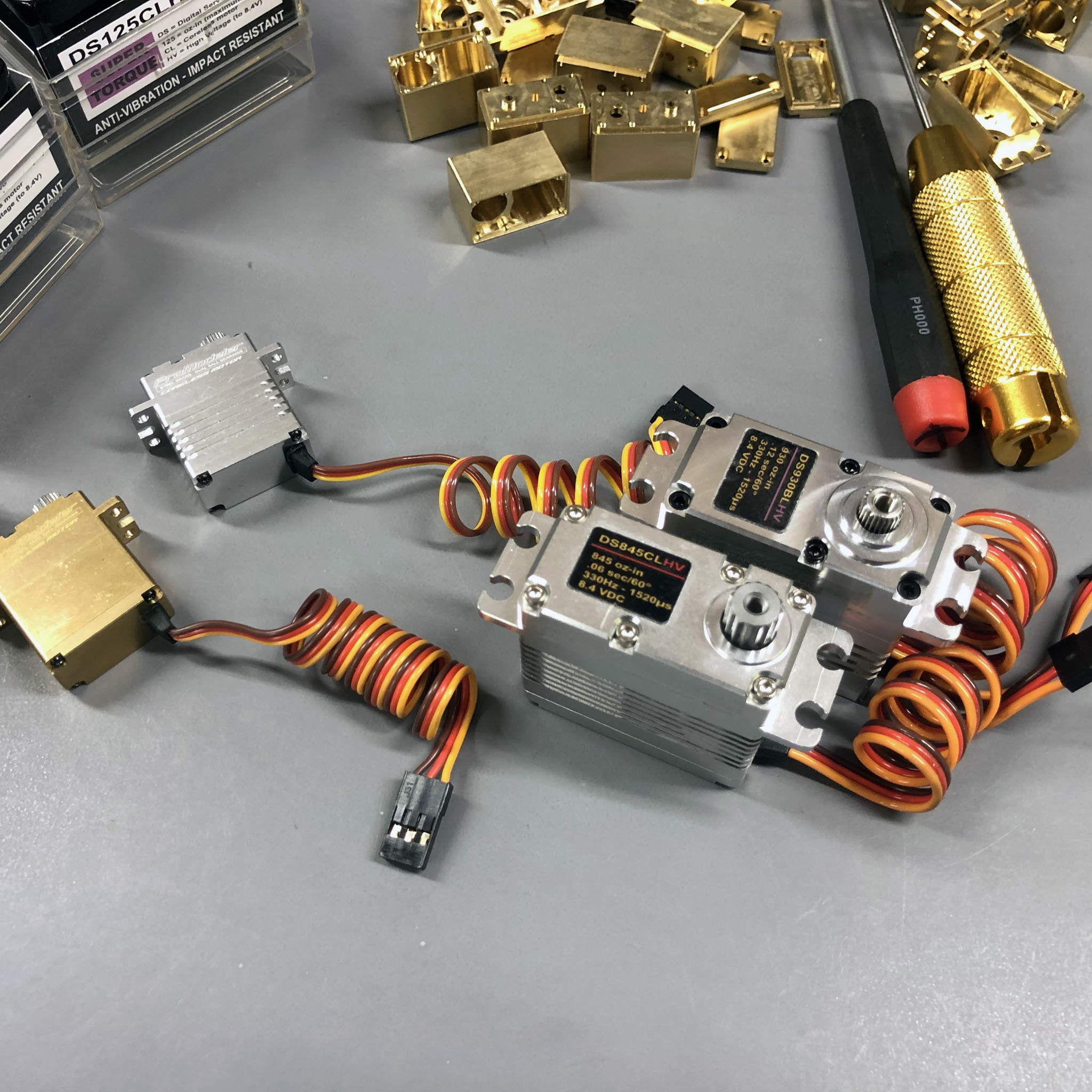
- DS845BLHV versus DS930BLHV - Series II vs. Series I standard-size servos head to head
Part 1 - is titanium the best for gears?
The only high pressure application I'm aware of where titanium gearing is used are hobby-grade servos. Once you move to professional-grade servos (like what ProModeler specialize in, meaning servos expressly designed for defense and industry), we only use steel gears. Yes, hobbyists buy them as well but 8% of our business doesn't move the needle (meaning hobbyist-sales are not our focus).
- My point? If you look at the wider world, specifically amongst the most
demanding applications, the gear trains? Steel. Every. Single. Time.
Look, I don't know how to reach those already persuaded to the view titanium gears are good. Not without coming off as . . .
- dismissive
- insulting, or
- condescending
Why not? Is it because I think they're too stupid? Oh heck no, of course not! If anything, it's more like I feel sorry for them. Why? It's because they never stood a chance. Let me try to explain - and - try to persuade without ruffling feathers or otherwise causing offense (e.g. invoking a defensive reaction).

Part 2 - psychology
Look, in poker nobody wants the card shark around, right? Some companies employ them, professionally. Psychologists. They know people, and their tells.
It's my opinion so many guys buying into titanium gears never stood a chance because they loosed the sharks amongst us (psychologists), e.g. the marketing department. These guys know just uttering the words carbon fiber or titanium makes rubes reflexively reach for their wallets because of all we've been taught!
For example, raise your hand if you don't know the lore of the SR-71 Blackbird in which titanium allowed it to go +2200mph. Is it deceptive for marketing to leave non-engineers believing titanium makes sense as servo gears?
Seriously, how is a material perfect for the skin of something at 900°F because of air friction (Mach 3) make any sense in a servo that won't see that kind of temperature - not even whilst going poof because some fool let 50V loose amongst his 8.4V control electronics? Nope, not in a million years!
But titanium helps sell servos despite being so soft it wears too quickly compared to steel. Honestly, for gears? Titanium sucks! It breaks relatively easily and it's expensive. But marketing doesn't care because their job is to sell servos. So if they befuddle you - all's fair in love and war - right? After all, it was from the Asians themselves there arose the concept of business being war!
So it's my opinion those who initially made the determination servos with titanium gears were a good thing didn't do it because they're dumb, but because they were tricked. Me? I am put in mind of the old saw about fool me once so, when the best marketing companies hire psychologists expressly to manipulate people, (and it's their job, so you can't get mad but it's literally Harvard-class trained psych-ops versus regular guys) and I say tricked because it was never a fair contest.
Remember, marketing's job is selling snow cones to Eskimos! So my objective with this briefing? To ensure you're not suffering the shame of being fooled twice!

Part 3 - material science
Titanium, very soft compared to steel, and brittle, really only survives in hobby grade-use as gears because they're typically sold to novices. Folk, who whilst often new to the sport are snookered early with buzzword marketing. That, and because rookies are not really stressing their equipment like seasoned drivers.
So what about actual pro-level drivers? Like those featured in magazine advertisements? Don't forget the a, b, c's of marketing; meaning what goes on behind the scenes, which you don't get to see like; a) they're paid to say what they say, b) they're provided servos for free, and c) said servos are frequently exchanged for brand new to maintain their performance.
Anybody giving you new servos for free? Point being, if you're sponsored by Mastercard, here's a tip, buy servos with steel gears for your rigs. Period.
- And note, this is not just my opinion because I have a dog in the hunt representing ProModeler, it's physics - math.
- Note as well, my pet theory is marketing is who wants titanium, not engineering. Why do I say this? Because just like hairdressers gossip, engineers talk amongst ourselves, the exact same way. It's a big world but quite tiny, professionally, so I know for a fact they have really good engineers because we talk, we meet at trade shows, and we even knock back a few beers together. Maybe not friends, but friendly competitors.
- But 'Decisions' with a capital-D get made by the C-suite using marketing. Not by engineers, except at ProModeler because we don't have a marketing department. We have no programs, no advertising, no spiffs, no distributors, no
teams, no hobby shops, no field rep programs . . . none of the inventions of marketing!
Instead, we iterate our approach until there's nothing left to make better. You know who else does this? Porsche. Eyeball a 911 from 30 years ago and one made yesterday. Both look very much alike; recognizably the same car for their respective eras - but - they are totally different because of an unrelenting focus on making it better. We do this, too.
Don't believe me? You actually don't need to be an engineer, you just need a set of eyes and you can prove it for yourself.
Take machinery like construction equipment? Caterpillar comes to mind. Steel gears. Formula 1 cars built with cubic money and making thousands of horsepower? Steel gears. Sticking with the automotive world, NASCAR, their cars 100% use steel gears. Drag racing, the most highly abusive of all equipment? Steel gears. Visit Moab, where guys are crawling in 1:1 scale and guess what? Steel gears - again.
Want more proof? My personal Arrma Infraction? Stupid fast. It's equipped with the best aftermarket gears money can buy? Yup, made of steel. So as a wise wag once observed . . .


Part 4 - label engineering
The market for RC cars and trucks is hot. Enough so to attract a different class of servos. These are the Asian imports with maybe something like 45Kg lasered on the side. They're sold straight out of the orient by Amazon and eBay and delivered to America by the US Mail and aimed at the unknowing, the inexperienced, plus the bottom feeders building rigs for others.
These same manufacturers, if you offer to buy 100 of their servos will put your name on it instead of theirs. This is termed label engineering.
Just also remember, they're largely engineered to be cheap. And they're cheaply made. Look inside if you doubt me. You'll see.
Major point being, don't mistake brands for actual manufacturers. Not like us, or our top quality competitors like a Futaba, Hitec, Savox, and MKS. The label engineered guys don't make jack. Smart guys? Oh yes, 'not' saying different - but - no engineers on staff, no clue regarding design tools, and certainly no machine tools.
With regard to label engineering brands, I'm kind of put in mind what they say in Texas about guys that are all hat, know what I mean?
Of course there's nothing wrong with earning money selling something you don't make, just watch out for the quick buck artists, capisce? Meaning ones who approach a giant Asian manufacturer, doll up a pretty label, and list them on Amazon and eBay for the purpose of turning a fast buck. Thing is, they don't have skin in the game. Not in the same way. Heads up, eh?

Part 5 - so if steel is better, and the best all have steel, how do you make the very best?
This part is actually easy. For us at least. To begin, we first made the gears bigger because all else being equal, bigger is better! Stronger. More durable.
For competitive reasons we licensed the design to others (because we couldn't afford to defend in international patent courts). We're just too small to take on multinational corporations, so a few bucks in the hand in the way of royalties beats a big fat nothing (and loads of aggravation). Wasn't a hard decision.
So we offer standard servos with bigger gears, our Series II servos. Others do also because we gave in to the inevitable. Not proud of it but hey, you do what you have to to survive because you can't eat pride! Better to live to fight another day. Maybe read up on the Wright brothers and their incredible - but doomed to failure - defense of their innovative wing warping for roll control. Curtis came along with the aileron and to the mat they went in court. Curtis won.
Back to our servos, there's more; first, eyeball the relative size of the gear trains of our Series II DS845 versus the very well regarded Savox SB2290SG in the photo below. This, to get an idea of what we mean when we say our Series II offer larger gears. Just look at the size of those monsters. Now do you understand how they much better they'll hold up to being abused? Bu that's not the end of it.
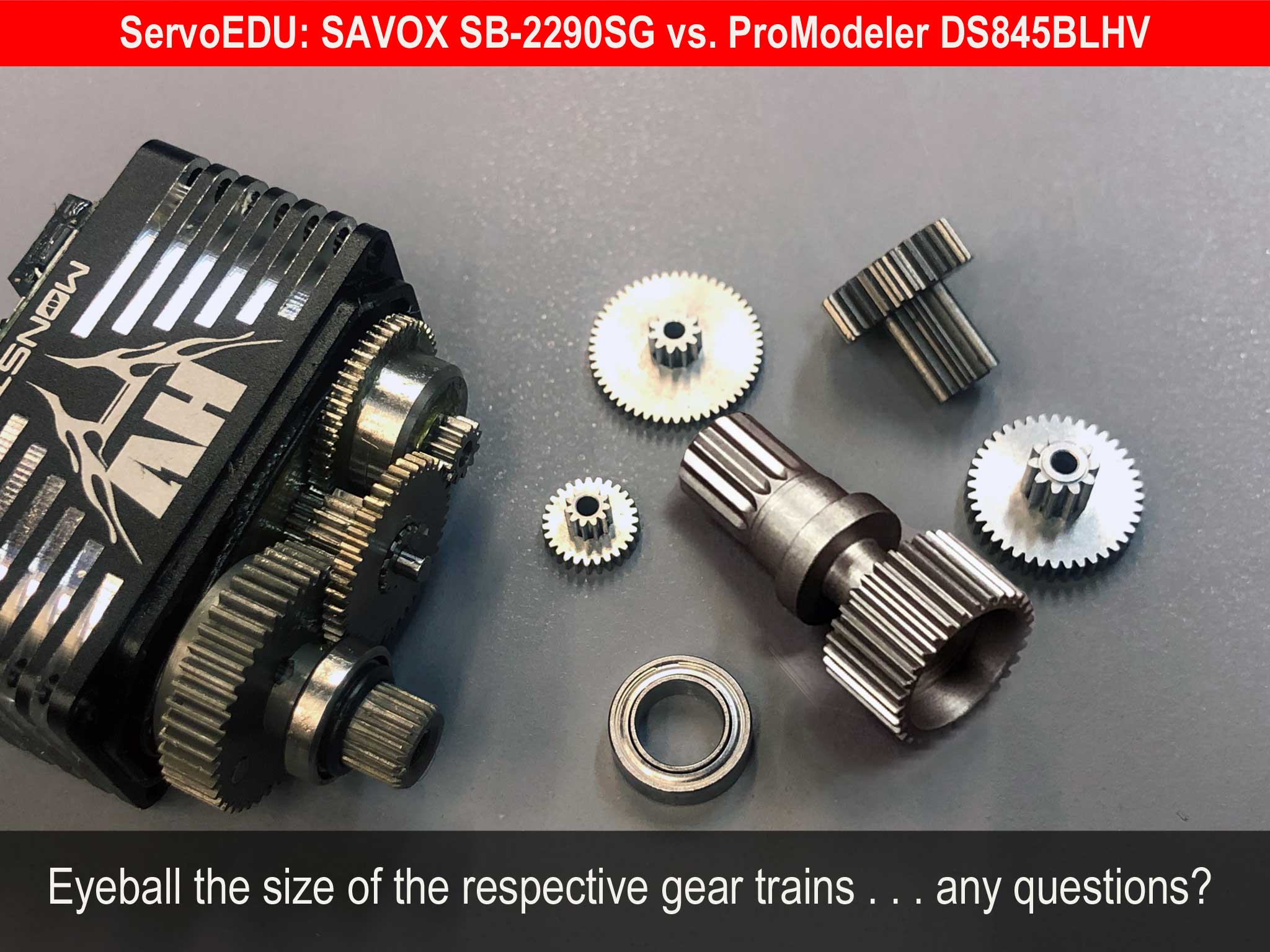
- The high quality Savox SB2290SG has steel gears, but our Series II, like DS845, are larger.

Another ProModeler innovation beyond larger gears, includes moving to a larger, and far more robust output shaft splines. We're now using the same ø8-15T splines as for our large scale servos. Note the difference in the splines in the above photo as the Savox sports ø6-25T splines versus the massive ø8-15T of the DS845 gear set.
Why larger splines? Simple, it's because we produce standard size servo that are so fast and powerful they can, being made of steel, simply rip the splines made of aluminum from within the 25T output shaft-pocket of a servo horn. Wipe them smooth. Clean off - like they were drilled with a 1/4" drill bit. Not kidding, these servos are bad ass.
Note, below is the spline used in all our Series II servos, DS635BLHBV, DS845BLHV, and DS1155BLHV. The DS845 in the photo below is representative of the group. And how is this perspective photo grab you of the DS845BLHV on the left and the DS930BLHV, no slouch in its own right, on the right.
The ø6-25T splines on the right are what's on all label engineered servos and all our competitors - except - the very well made MKS HBL399 which also uses an 8mm spline.
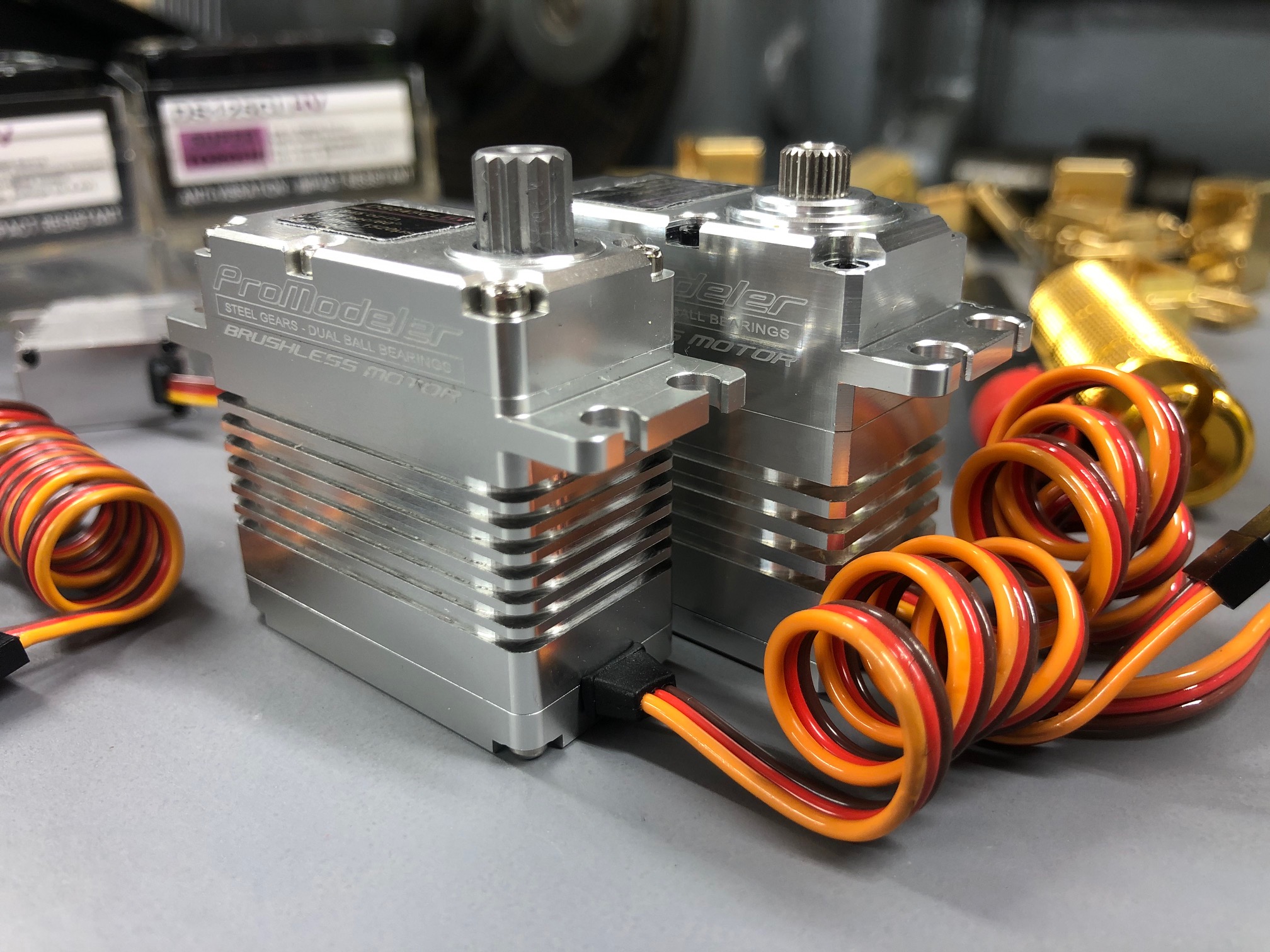
- Massive Series II splines on the left versus Series I, and ALL of our competitors on the right

So for these beefier servos (our Series II) we dug into the parts bin and adapted our much larger 1/5th spline to our next generation standard size servos. Basically our goal was to make their juncture with the servo horn bulletproof.
These are massive and exactly like what we use on servos producing 2180oz-in. Bigger? Yes. How much bigger? Their diameter is 33% larger (nominal 8mm diameter instead of 6mm). And equipped with genuinely gnarly teeth (15T instead of 25T) their much larger profile precludes ripping out the inside of the horn. Yes, they're still standard size servos, but with larger gears - and - with a larger spline. Basically, 'very best' is down to making the biggest baddest gear trains in the industry. Unmatched by anybody . . . at any price!
What am I saying with 'I feel we're unmatched with the DS930 except by our own Series II'? It's that we clean their clocks with Series I, and Series II beats Series I so all of our servos, but especially our Series II are bad boys - and - not to be confused with any competitor, none (but least of all by something that's the product of label engineering).
And yet there's more so next let's take a peek inside.
Part 6 - all standard servo designs are not equal
What do we mean by this? Take a gander at the gear train of a DS930 below. All steel. A beautiful product . . . by any standard!
- Some might say a work of art.
The softly gleaming gear train is strong and part of a purposeful servo. One, which in our opinion is better than any made - except - within our own lineup.
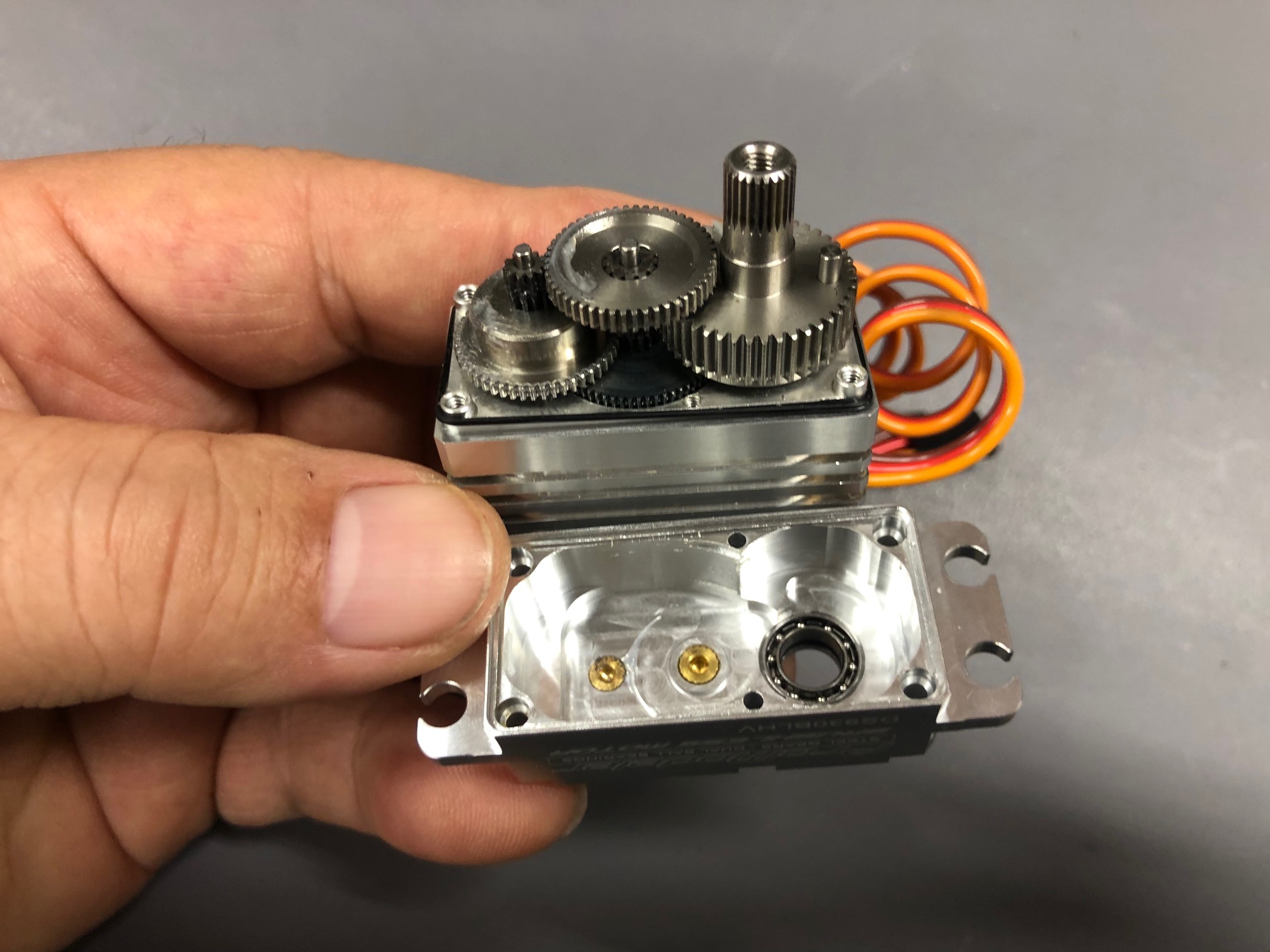
- Finely machined all steel gears within our DS930BLHV servo gleam softly and purposefully

So maybe after you finish gawking at the gear train, focus on the inside. Do you see the bronze inserts within the case? They make the pockets into which the steel gear shafts for the transmission section fit.
- Basically, they beef up the aluminum case.
No, bronze isn't as hard as steel - but - it's a LOT harder than aluminum - and - it has desirable lubricating properties. These bits of bronze are known as hard points. Their purpose is keeping the bores for the gear shafts (round), e.g. from going egg-shape (not-round) due to the abuse dished out by bashers and their incessant and abusive pounding.
Hard inserts are part of how we keep our gear train together 'and ' meeting spec for the gear mesh. Once the bores get beaten so they're not round, gear mesh goes to heck, backlash ensues and before long they fail.
Seriously, do you think el cheapo servos have these? Are you kidding me? Heck, even amongst servos selling for more than ours, many don't have this, either. However, from amongst the better servos? Like by Futaba, and MKS as examples? Oh yes, amongst our first tier competitors yes, absolutely.
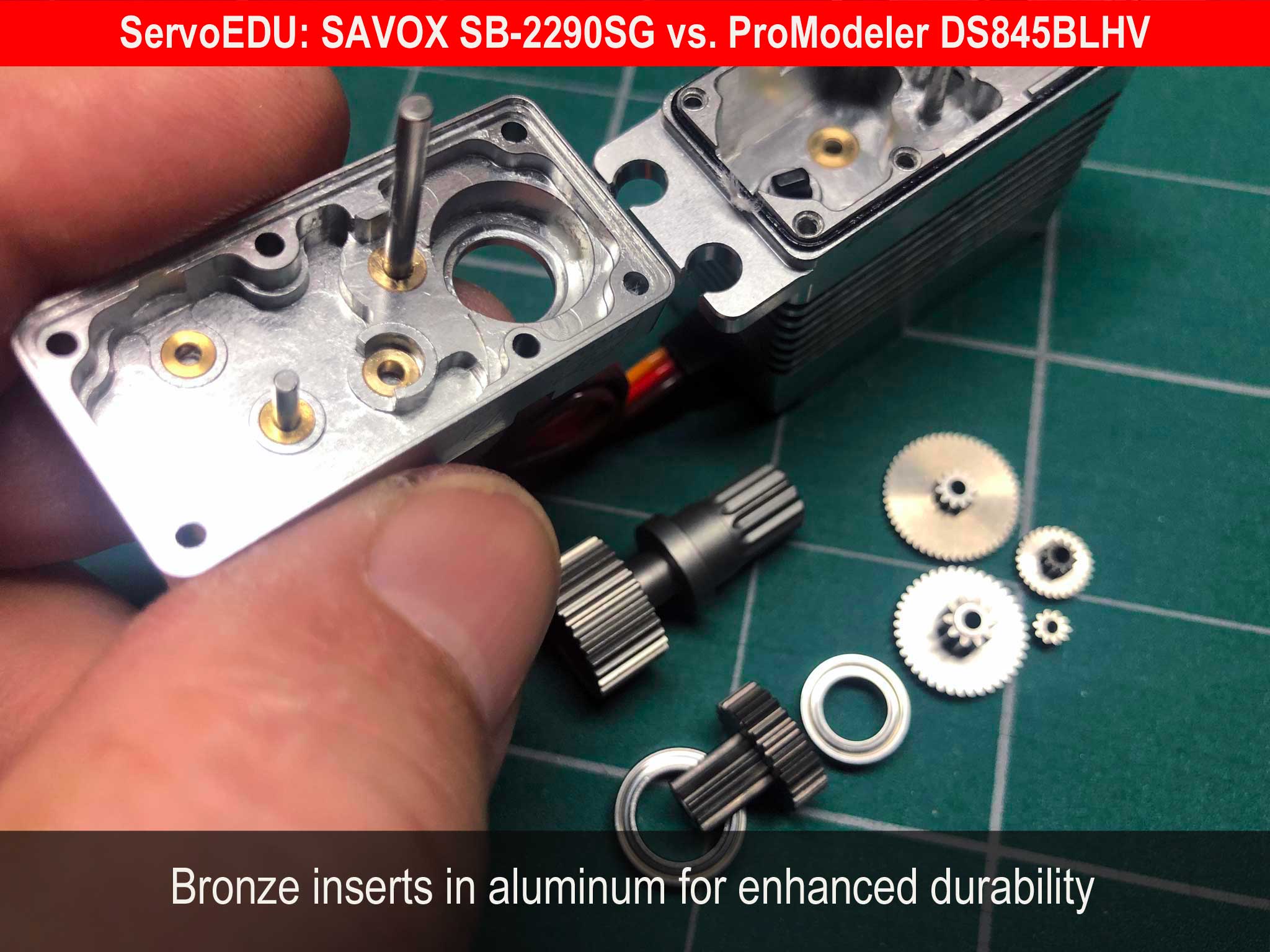
- Look inside is my best advice regarding what separates the men from the boys look for yourself!
So if you're going to drop a bundle on the best servo for your rig, then riddle me this, what features do you expect will better protect your investment? Will it be the servo with steel shafts sitting directly within aluminum bores, or the more finely made high quality servos made with bronze reinforcements? It's your money. You earned it the hard way, so my advice is don't get beaten out of it by tricksters and impersonators.

Bottom line?
Maybe you're not an engineer, but even if you're new and inexperienced in the sport, then after reading this now you better know what to look for. As for the incognito keyboard experts on the internet hiding behind cute handles, and dispensing advice with who knows what for an agenda? Honestly? Idunno, I have no opinion.
Our advice? Watch out for your own best interests and use your eyes because nobody else is gonna do it for you! And don't just look at the gear train, pop the bottom cover off and look there, also!
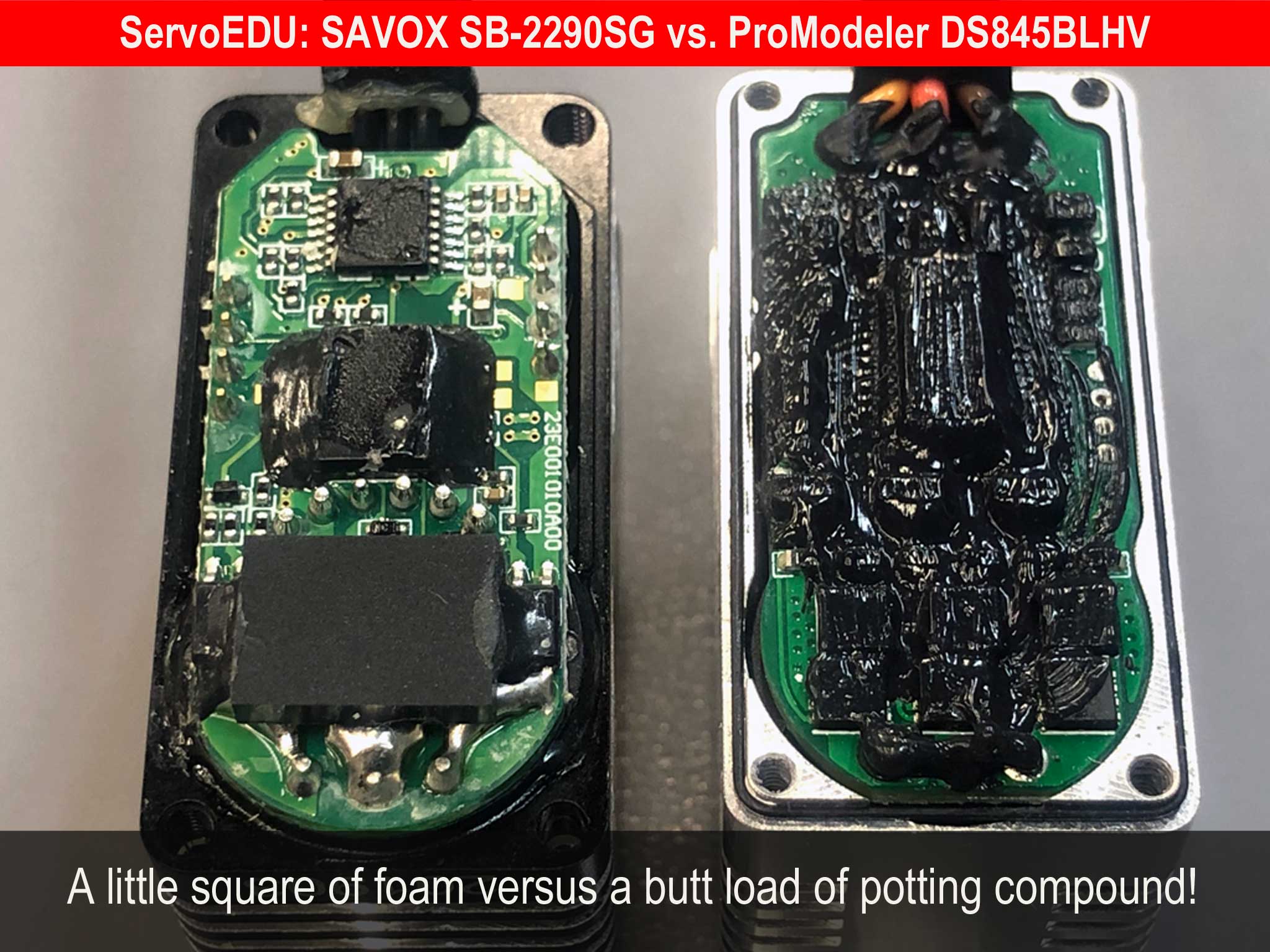
There's a reason ProModeler servos meet three MIL-STDs whilst the other guys? Dunno!

Part of what makes the ProModeler DS845BLHV and all ProModeler servos better than competitors is that unlike hobby-grade servos, they're built to meet military standards (and subjected to these tests).
MIL-STD-810G-Part 16
- Shock - Test Method 516.6
- Vibration - Test Method 514.6
- Rain - Test Method 514.5
In part, this is due to the requirements of our primary customer. However, because we're modelers and have knocked a servo off a workbench, experienced crashes, and know a thing or two about engine vibration (plus how fun it is to conquer a small stream), it means these tests are important for civilian users as well.
So if you're looking at another servo, one which maybe offers similar performance and pricing, but hasn't been tested to military standards, then which would you rather have?

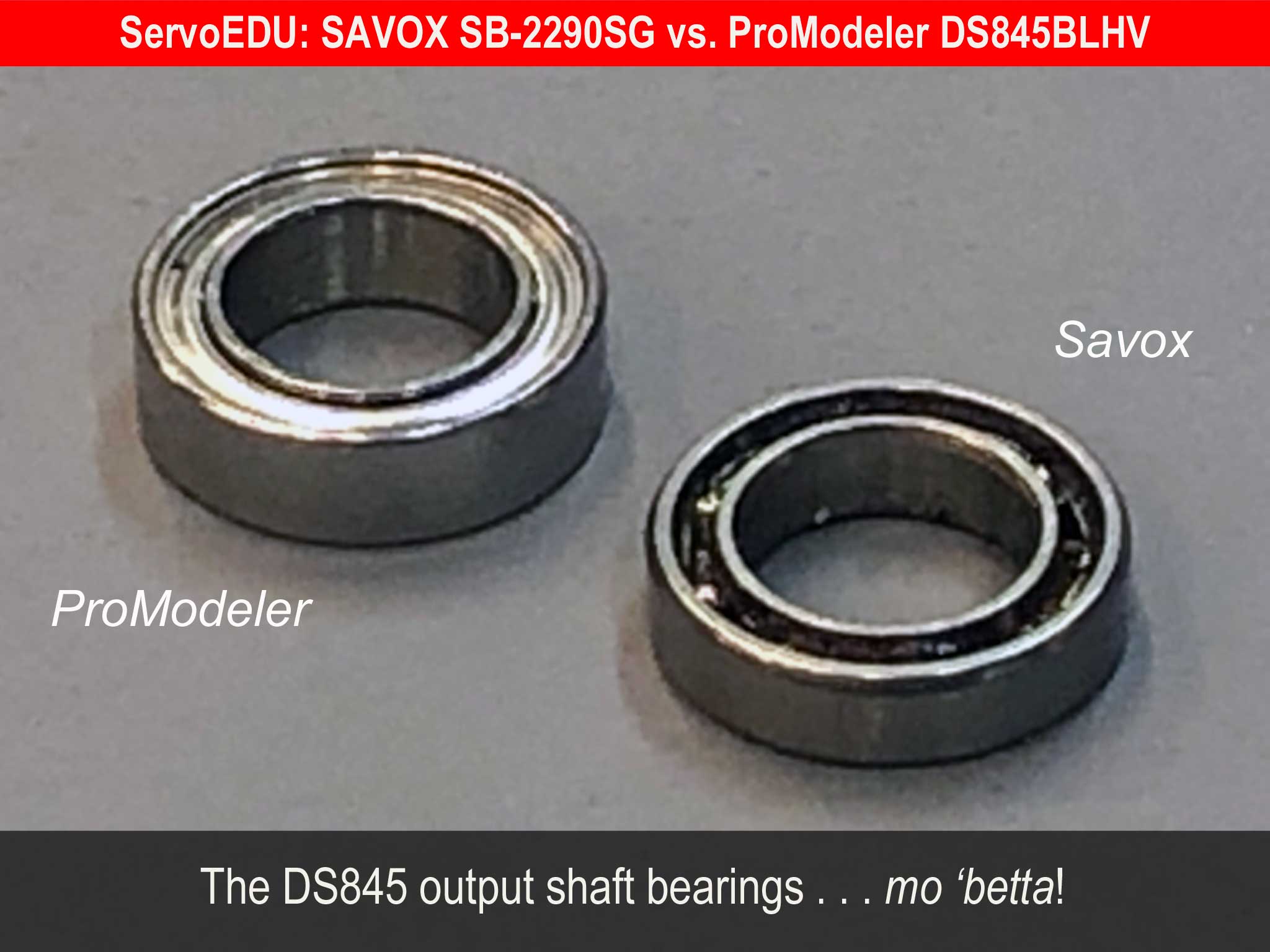
In closing, if you have any further questions, reach out to me via email:
- or if it's urgent, call; 407-302-3361
. . . because I love bullshitting about models more than anything!